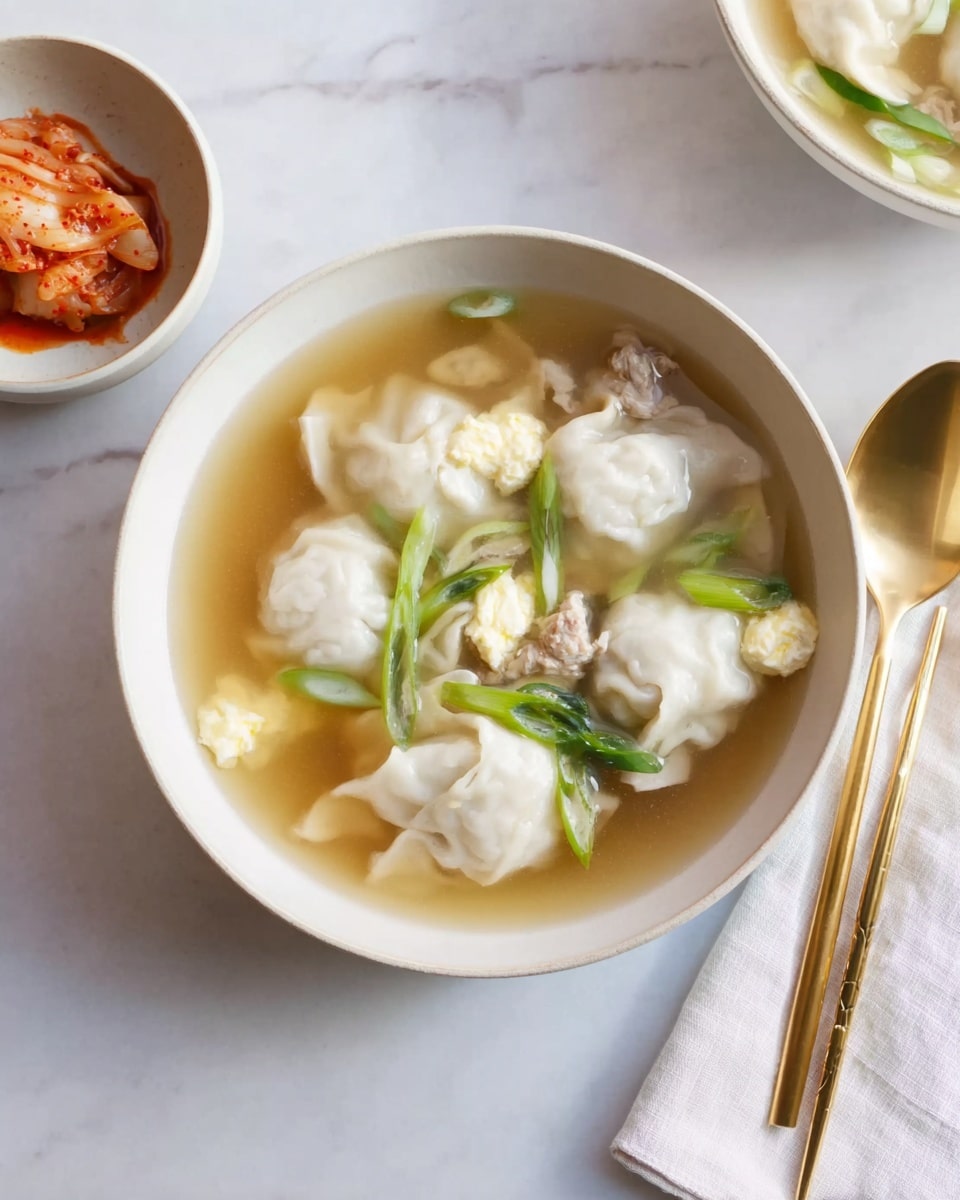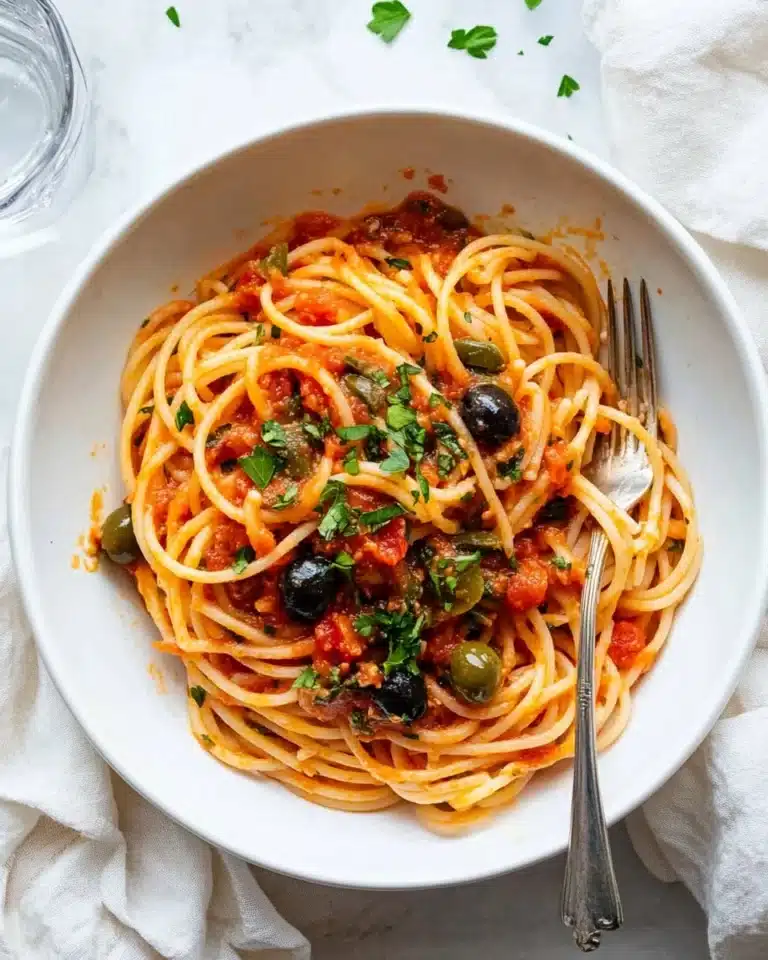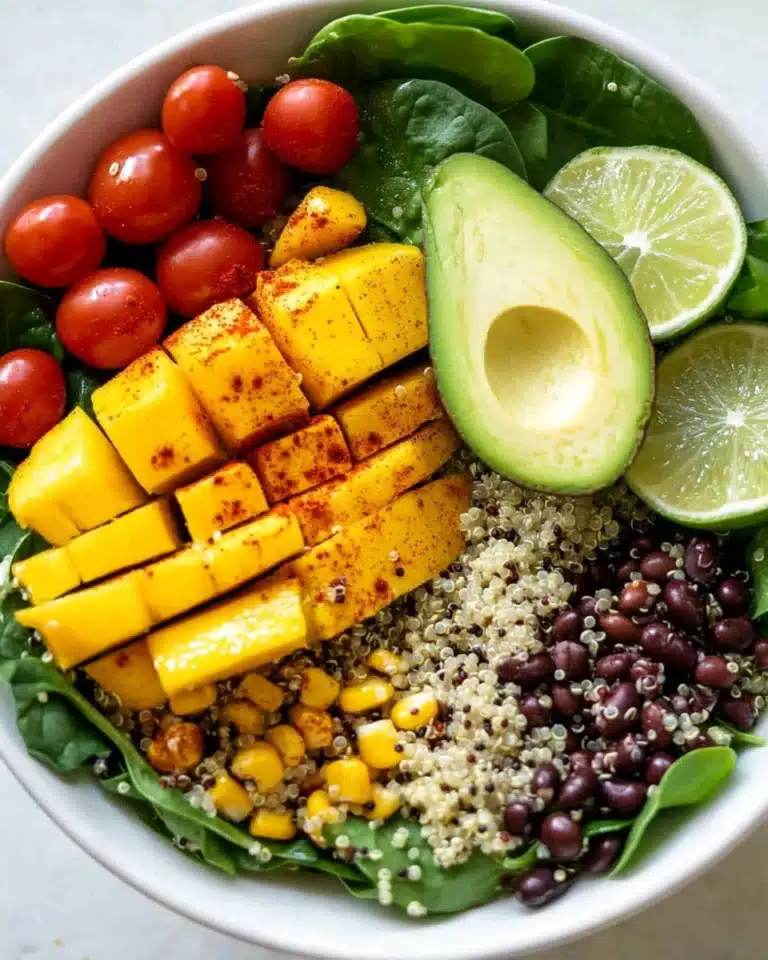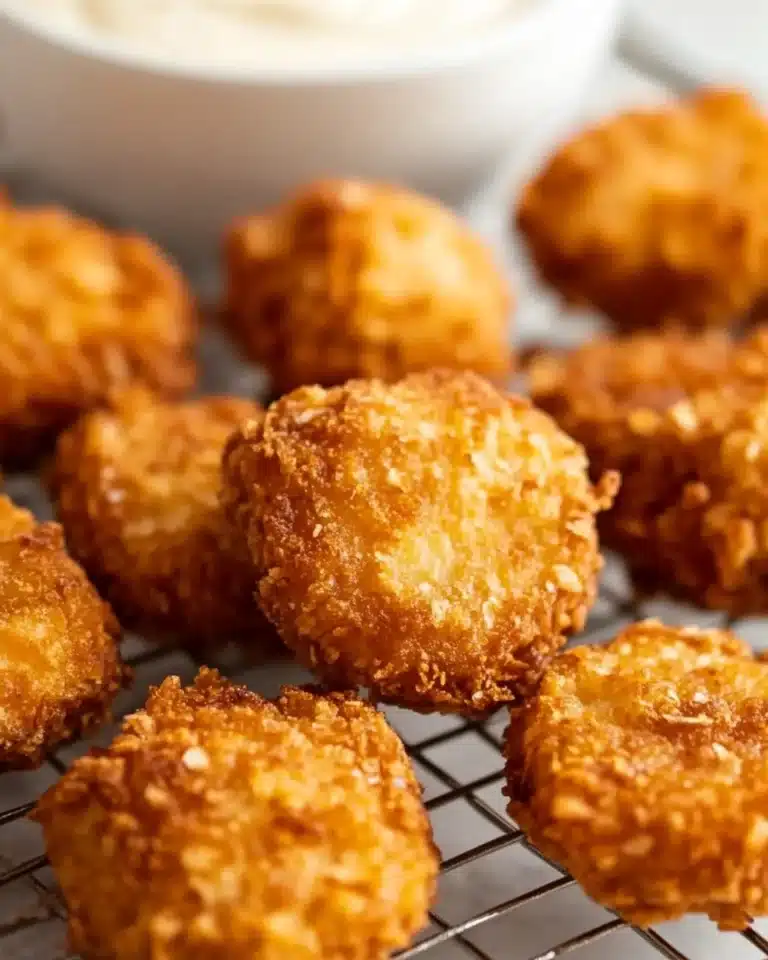If you’re craving something cozy, comforting, and packed with flavor, you’re going to absolutely adore this Mandu Guk (Korean Dumpling Soup) Recipe. It’s that perfect bowl of warmth that feels like a hug from the inside—thanks to hearty beef broth and those irresistibly soft dumplings. Trust me, once you try this recipe, it’ll quickly become a go-to whenever you need a little culinary comfort.
Why You’ll Love This Recipe
- Simple Yet Flavorful: The beef broth simmers gently with garlic and soy sauce, creating a rich base without needing hours of cooking.
- Customizable Comfort: Whether you want to use homemade or store-bought mandu, fresh or frozen, this recipe works beautifully all ways.
- Perfect for Any Occasion: From weeknight dinners to festive gatherings, Mandu Guk brings that special, hearty touch everyone will rave about.
- Impresses Without Fuss: I’ve found this soup comes together easily but tastes like you spent all day in the kitchen.
Ingredients You’ll Need
Finding the right balance of ingredients for Mandu Guk is what makes it shine. Key staples like beef brisket for broth depth and fresh green onions for brightness really bring this Korean soup alive.
- Beef brisket or chuck: This gives your broth a deep, meaty flavor that’s pure comfort in a bowl.
- Garlic: Freshly minced garlic amps up the aroma and adds a subtle, savory kick that sets the tone for the soup.
- Soy sauce: Just the right touch to add umami without overpowering the delicate flavors of the broth.
- Water: The base for your broth, making sure it stays light yet flavorful.
- Mandu (Korean dumplings): Whether homemade or store-bought, these dumplings are the stars of the show—I use fresh when I have time, frozen when I don’t.
- Eggs: They create beautiful, silky ribbons in the soup for extra texture and richness.
- Green onions: Sliced diagonally, they add a lovely fresh crunch and color.
- Toasted sesame oil: A few drops bring that unmistakable nutty warmth that defines Korean cooking.
- Salt and pepper: To season perfectly—always start small and adjust as you go!
- Roasted nori (seaweed sheets): Optional, but I love sprinkling this on top for an extra layer of flavor and texture.
Variations
I love mixing things up with Mandu Guk depending on the season or what’s in my fridge, so don’t be afraid to tailor this recipe to your tastes.
- Vegetarian version: Swap beef broth with vegetable broth and fill your mandu with kimchi or tofu for a delightful meat-free twist.
- Spicy kick: Add a spoonful of gochujang (Korean chili paste) while simmering the broth for a nice heat boost—my family goes crazy for this one!
- Extra greens: Toss in some baby spinach or napa cabbage near the end for more veggies and texture.
- Homemade mandu: Making your own dumplings can be a fun weekend project, and you’ll definitely notice the fresh difference inside your Mandu Guk.
How to Make Mandu Guk (Korean Dumpling Soup) Recipe
Step 1: Marinate the Beef for a Flavor Boost
Start by mixing your beef brisket or chuck with minced garlic and soy sauce in a bowl—this marinade sets the foundation for a super flavorful broth. Let it sit while you prep the rest of your ingredients, or if you have time, a short 10-minute rest helps the flavors really sink in.
Step 2: Simmer the Broth Low and Slow
Bring 10 cups of water to a rolling boil in a large pot, then carefully add your marinated beef along with any extra marinade liquid. Drop the heat to low and cover the pot, letting it simmer gently for 30 to 35 minutes. This slow simmer draws out all the savory goodness into your broth—don’t rush this part or you’ll miss out on that rich depth.
Step 3: Add Mandu and Cook to Perfection
Once your broth has developed flavor, gently add your mandu. Whether fresh or frozen, increasing the heat back to a low boil cooks the dumplings just right. You’ll notice fresh mandu turning translucent and floating after 5 to 9 minutes, while frozen ones usually take about 12. Keep an eye on your package instructions if you’re using store-bought ones. It’s so satisfying to see those plump dumplings bob up to the surface.
Step 4: Create Silky Egg Ribbons
In a small bowl, lightly whisk your eggs until evenly combined. Slowly drizzle the eggs into the hot soup while stirring gently with your spoon—this helps the eggs disperse into soft, ribbon-like bits that float beautifully throughout the broth. If you pour eggs in without stirring, they’ll clump up and stick to your pot, and that’s not the texture we want.
Step 5: Final Flavor Boost and Serve
Turn off the heat and stir in your green onions and toasted sesame oil. Season with salt and pepper little by little—this is the moment to taste and adjust. I always find that a pinch more salt or a crack of pepper really brings the whole soup together. Serve it hot, topped with shredded roasted nori for that extra umami pop. Your Mandu Guk is ready to warm you up from the inside out!
Pro Tips for Making Mandu Guk (Korean Dumpling Soup) Recipe
- Use Quality Beef Cuts: I discovered that brisket or chuck adds just the right balance of flavor and tenderness after simmering—you’ll taste the difference compared to leaner cuts.
- Gentle Egg Incorporation: Stir while drizzling eggs slowly for those pretty egg ribbons; trust me, pouring too fast creates clumps that aren’t as nice.
- Timing is Everything with Mandu: Fresh and frozen mandu cook differently, so don’t skip reading those package times or you might under- or overcook them.
- Season at the End: Adding salt and pepper last means you won’t over-season the broth, which is easy to do early on since soy sauce adds saltiness.
How to Serve Mandu Guk (Korean Dumpling Soup) Recipe
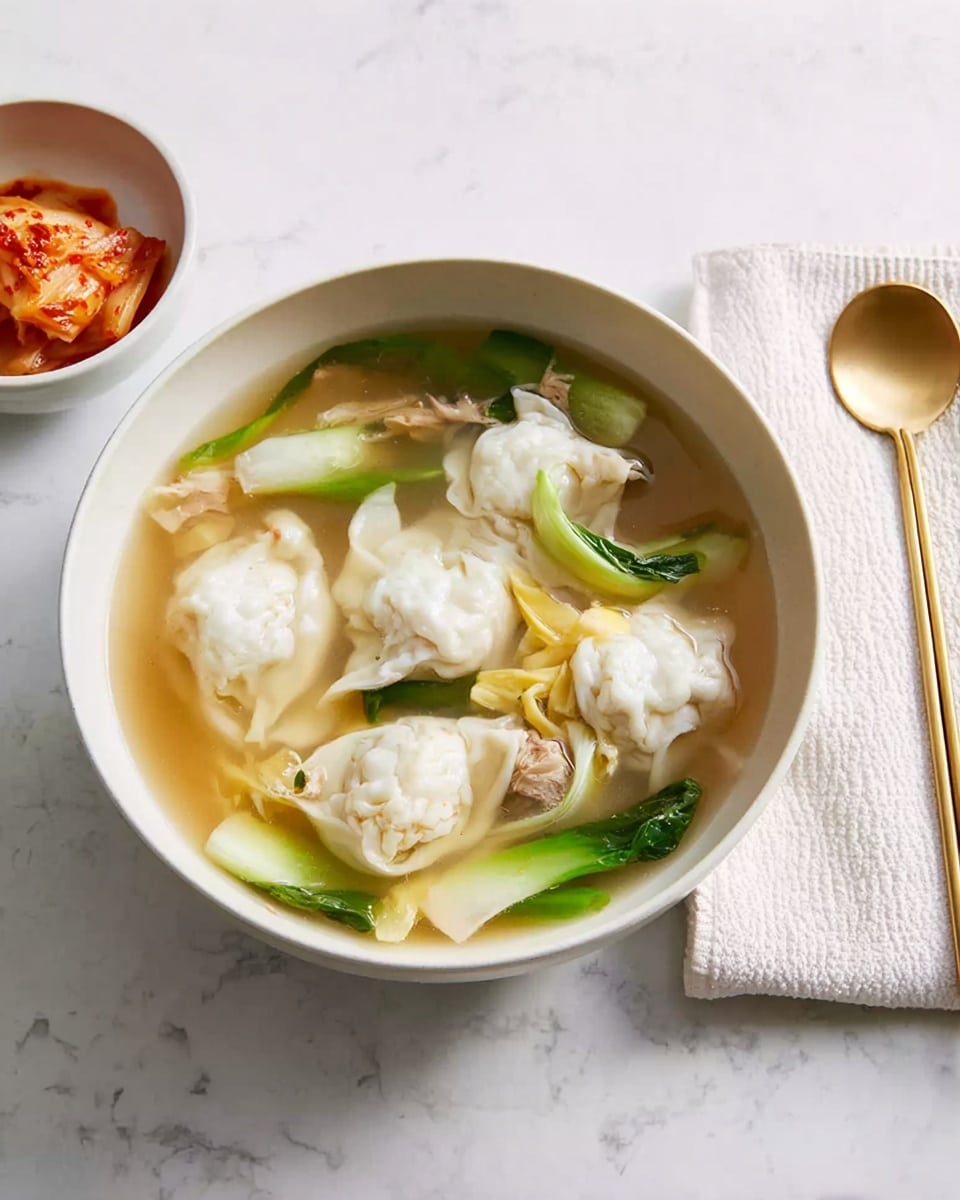
Garnishes
I always top my bowls of Mandu Guk with shredded roasted nori for a subtle sea flavor and some extra crunch. Sometimes, I add a sprinkle of toasted sesame seeds and a few sliced green onions right before serving—it really brightens the soup up! A drizzle of chili oil is another favorite when I want a touch of heat.
Side Dishes
This soup pairs beautifully with classic Korean sides like kimchi or pickled radish, which cut through the richness and add contrasting textures. For something heartier, I’ll whip up some steamed rice or a crunchy cucumber salad on the side to complete the meal.
Creative Ways to Present
For special occasions, I like serving Mandu Guk in rustic bowls with a sprinkle of chopped chives and a wedge of lemon on the side for a bright pop. Floating in a few edible flowers or microgreens can turn this humble soup into something that looks like a work of art on the table.
Make Ahead and Storage
Storing Leftovers
I usually keep leftover Mandu Guk in an airtight container in the fridge, and it stays surprisingly fresh for up to 3 days. Just be sure to immerse the dumplings in the broth to keep them from drying out. You’ll find the flavors actually deepen after a day or two.
Freezing
Freezing Mandu Guk can be a bit tricky because dumplings tend to get softer after thawing. If you want to freeze it, I recommend doing it before adding the mandu—freeze the broth separately, and add freshly cooked dumplings when reheating. This saves texture and keeps everything tasting fresh.
Reheating
I gently reheat leftovers on the stovetop over low heat, stirring occasionally so the mandu doesn’t stick or break apart. Adding a splash of water can refresh the broth if it’s thickened too much overnight. Avoid microwaving when possible—it tends to make dumplings rubbery.
FAQs
-
Can I use store-bought mandu for this recipe?
Absolutely! Store-bought mandu works wonderfully here, making this soup quick and easy to prepare. Just follow the cooking times on the package to ensure they’re cooked perfectly, and you’ll still get that authentic Mandu Guk experience.
-
What kind of beef is best for Mandu Guk broth?
Beef brisket or chuck are my top picks because they have enough fat and connective tissue to make a rich, flavorful broth after simmering. Lean cuts can work but might result in a less hearty taste.
-
Can I freeze Mandu Guk soup with dumplings already cooked?
It’s better to freeze the dumplings separately or not at all, since freezing cooked mandu in broth can affect their texture, making them softer or mushy once thawed. Freezing just the broth and adding freshly cooked dumplings when reheating is your best bet.
-
How long does Mandu Guk last in the fridge?
Stored in an airtight container, Mandu Guk keeps well for up to 3 days in the refrigerator. Make sure the dumplings stay submerged in the broth to prevent drying out.
Final Thoughts
This Mandu Guk (Korean Dumpling Soup) Recipe isn’t just dinner—it’s a little tradition I’ve come to cherish. It’s simple enough to whip up even on a busy weeknight but special enough that it feels like a celebration. The way the dumplings float in that flavorful broth, flecked with egg ribbons and green onions—it’s pure soul food. I hope you give it a try soon, and when you do, pour yourself a warm cup of tea and savor every spoonful just like I do!
Print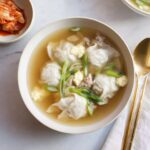
Mandu Guk (Korean Dumpling Soup) Recipe
- Prep Time: 10 min
- Cook Time: 45 min
- Total Time: 55 min
- Yield: 6 servings
- Category: Soup
- Method: Stovetop
- Cuisine: Korean
Description
Mandu Guk is a comforting Korean dumpling soup featuring tender beef brisket simmered in a savory broth, paired with delicate mandu dumplings, ribbons of egg, and garnished with green onions and toasted sesame oil. Perfect for a satisfying and flavorful meal, this soup blends rich umami notes with the ease of store-bought or homemade dumplings.
Ingredients
Beef Soup Base
- 1 pound beef brisket or chuck, cut into 1- to 1 1/2-inch pieces
- 4 cloves garlic, minced
- 4 tablespoons soy sauce
- 10 cups water
Dumplings and Soup Additions
- 32 homemade or store-bought mandu (Korean dumplings), fresh or frozen
- 2 large eggs
- 4 green onions, trimmed and cut diagonally into 2-inch slices
- 2 tablespoons toasted sesame oil
- 2 teaspoons salt, plus more to taste
- 1 teaspoon white or black pepper, plus more to taste
For Serving
- 2 roasted nori (seaweed sheets), for serving
Instructions
- Season the beef: In a medium bowl, combine the brisket, minced garlic, and soy sauce. Set it aside to marinate briefly, allowing the flavors to penetrate the meat.
- Make the beef soup base: In a large pot over high heat, bring 10 cups of water to a boil. Add the marinated beef brisket along with the marinade. Reduce the heat to low, cover the pot, and let it simmer gently for 30 to 35 minutes until the beef becomes tender and the broth develops rich flavor.
- Add the mandu: Carefully place the mandu dumplings into the simmering beef broth. Increase the heat to bring the soup back up to a low boil. Cook fresh mandu for 5 to 9 minutes or frozen mandu for about 12 minutes, until the dumpling wrappers become translucent and they float to the surface. If using store-bought dumplings, follow package instructions for cooking times.
- Add eggs: Lightly whisk the eggs in a small bowl until fully combined. As soon as the mandu are cooked, slowly drizzle the beaten eggs into the soup while gently stirring. This technique creates delicate egg ribbons throughout the broth instead of clumps.
- Add the green onions and sesame oil: Turn off the heat. Stir in the sliced green onions and toasted sesame oil. Season the soup with 2 teaspoons salt and 1 teaspoon white or black pepper, adjusting to taste as needed.
- Serve the soup: Ladle the soup and mandu evenly into 4 to 6 bowls. Crumble or thinly slice the roasted nori seaweed sheets and sprinkle over each serving to add a pleasant texture and flavor boost. Enjoy immediately as a warm, satisfying meal.
Notes
- Mandu Guk is a quick and flavorful Korean soup that can be made easily using either store-bought or homemade dumplings depending on your preference and time.
- The soup’s rich beef broth, infused with garlic, soy sauce, and sesame oil, provides a deep umami base for the dumplings and eggs.
- Adjust seasoning with salt and pepper to suit your taste at the end of cooking.
- Adding the eggs slowly while stirring ensures delicate egg ribbons rather than clumps in the soup.
- Roasted nori adds a traditional Korean touch and extra texture when sprinkled on top before serving.
Nutrition
- Serving Size: 1 bowl (approximate)
- Calories: 717 kcal
- Sugar: 2 g
- Sodium: 2222 mg
- Fat: 46 g
- Saturated Fat: 14 g
- Unsaturated Fat: 0 g
- Trans Fat: 0 g
- Carbohydrates: 29 g
- Fiber: 2 g
- Protein: 45 g
- Cholesterol: 200 mg

